(word完整版)高三英语复习状语从句教案.docx
- 格式:docx
- 大小:43.67 KB
- 文档页数:10
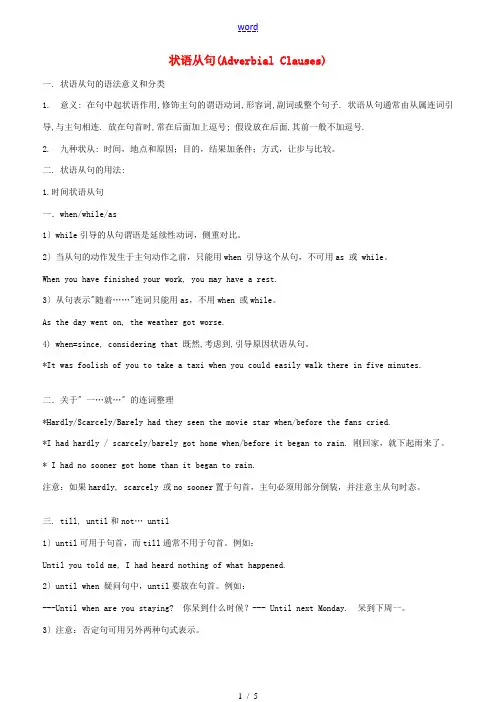
状语从句(Adverbial Clauses)一. 状语从句的语法意义和分类1. 意义: 在句中起状语作用,修饰主句的谓语动词,形容词,副词或整个句子. 状语从句通常由从属连词引导,与主句相连. 放在句首时,常在后面加上逗号; 假设放在后面,其前一般不加逗号.2. 九种状从: 时间,地点和原因;目的,结果加条件;方式,让步与比较。
二. 状语从句的用法:1.时间状语从句一.when/while/as1〕while引导的从句谓语是延续性动词,侧重对比。
2〕当从句的动作发生于主句动作之前,只能用when 引导这个从句,不可用as 或 while。
When you have finished your work, you may have a rest.3〕从句表示"随着……"连词只能用as,不用when 或while。
As the day went on, the weather got worse.4) when=since, considering that 既然,考虑到,引导原因状语从句。
*It was foolish of you to take a taxi when you could easily walk there in five minutes.二.关于〞一…就…〞的连词整理*Hardly/Scarcely/Barely had they seen the movie star when/before the fans cried.*I had hardly / scarcely/barely got home when/before it began to rain. 刚回家,就下起雨来了。
* I had no sooner got home than it began to rain.注意:如果hardly, scarcely 或no sooner置于句首,主句必须用部分倒装,并注意主从句时态。
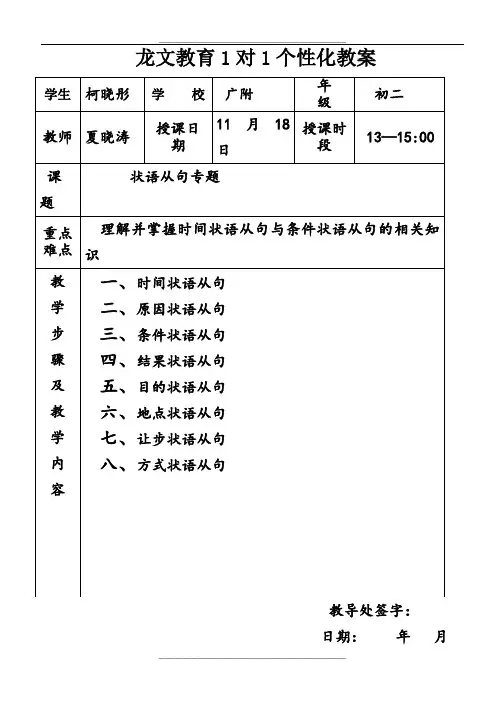
龙文教育1对1个性化教案教导处签字:日期:年月日状语从句由从句担任的状语,在句子中可修饰谓语(或其它动词)、形容词、副词或是整个句子,它可以用来表示时间、地点、原因、目的、结果、条件、方式、比较、让步等。
状语从句是一较大的语法项目,也是近几年高考题中常见的一个重要试点。
高考中已考查了时间、让步、地点、条件、目的等状语从句,这些从句仍是今后高考热点,应作充分准备。
同时对方式状语从句也应引起重视。
(一)时间状语从句表示时间的状语从句可由when, as, while, whenever, after, before, till (until), since, once, as soon as (或the moment ), by the time, no sooner … than, hardly(scarcely) … when, every time等引导。
e.g. When I came into the office, the teachers were havinga meeting.He started as soon as he received the news.Once you see him, you will never forget him.No sooner had I gone to bed than I went to sleep.比较while, when, as1)as, when 引导短暂性动作的动词。
Just as / Just when / WhenI stopped my car, a man came up to me.2)当从句的动作发生于主句动作之前,只能用when 引导这个从句,不可用as 或 while。
When you have finished your work, you may have a rest. 3)从句表示"随时间推移"连词能用as,不用when 或while。
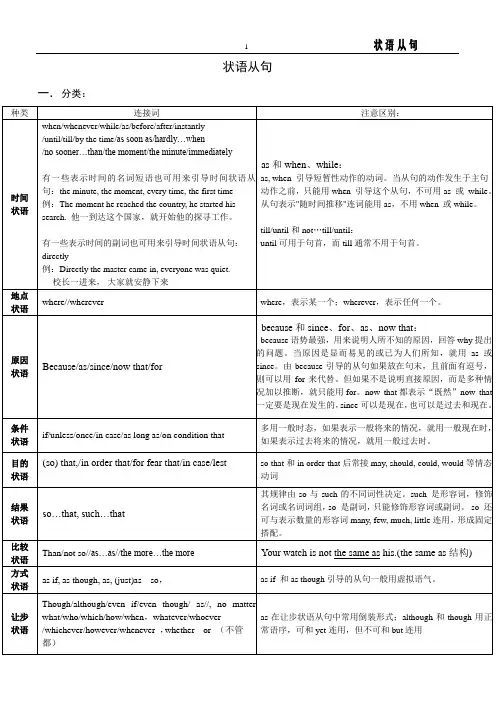
状语从句一.分类:when (当……的时候) while (在……期间) as (当……的时候, 一边……一边……)before (在……之前) since (自从……以来) till/until (直到) hardly…when… (刚……就) as soon as (一……就……)after (在……之后) not…till/until(直到……才)no sooner…than…(刚……就) 地点状语从句:where (在那里) wherever(无论哪里)原因状语从句:because (因为) since (因为,既然) as (由于) for (为了) now that(既然)目的状语从句:(so)that=in order that(以便)so as(not)to (以便[不])in case(以免)lest(以免)结果状语从句:so+adj./adv.+that(如此……以致)so that(结果……)such+n.+that(如果……以致)that(所以,因此)让步状语从句:though/although不可同but连用。
though/although (虽然)however (可是)even though/if(即使)no matter+what/which/where/who/when =whatever/whichever/wherever/whoever/whenever(不论什么/哪一个/哪里/谁/何时)比较状语从句:as (正如)as…as(和……一样)not as/so … as (不如……)than(比……更)the+比较级…+the+比较级(越……越……)条件状语从句:if(假设)unless(如果不)so long as(只要)on condition that (如果)方式状语从句:as(像……那样地)just as(正像)as if(好像)as though(好像)二.各种状语从句的简化方法:1作状语。
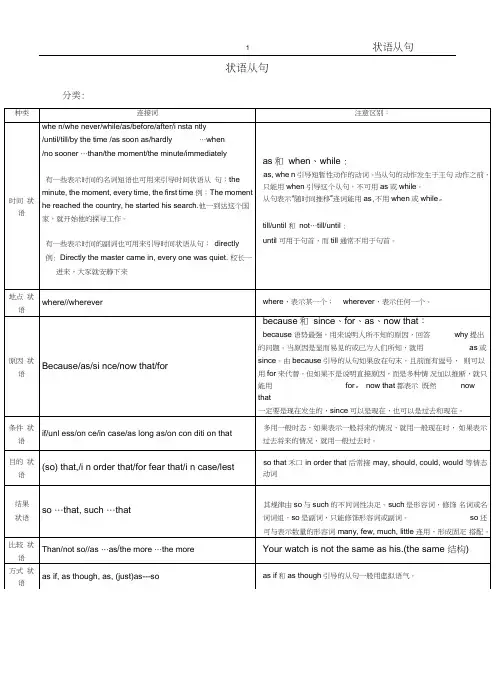
状语从句分类:3状语从句时间状语从句:when (当 .. 的时候)before (在 . 之前)while (在 ... 期间) since (自从 .. 以来)as soon as 一 .... 就 ... ) after (在 ... 之后) not …till/until (直至U .............. 才) no sooner …than 冈"( 就)地点状语从句: where (在那里) wherever (无论哪里)原因状语从句: because 因为) si nee (因为,既然)as (由于) for (为了) now that (既然)目的状语从句: (so ) that=in order that (以便) so as (not ) to (以便[不])in case (以免) lest (以免)结果状语从句:so+adj./adv.+that (如此 .... 以致)so that (结果 .. )such+n.+that (如果 .... 以致)that (所以,因此)让步状语从句:though/although 不可同but 连用。
though/although (虽然) however (可是)even though/if (即使)no matter+what/which/where/who/whe n =whatever/whichever/wherever/whoever/whe never(不论什么/哪一个/哪里/谁/何时)as (正如) as …as (和 ... 一样) not as/so …a (不如 ...... ) than (比 .. 更)the+比较级…+the+比较级 (越 ....... 越 ..... )if (假设)unless (如果不) so long as (只要)on condition that (如果) as (像 ... 那样地)just as (正像)as if (好像)as though (好像)各种状语从句的简化方法:1 .以after 和before 引导的状语从句的主语若与主句主语一致时, 从句等于after/before+doing sth.作状语。
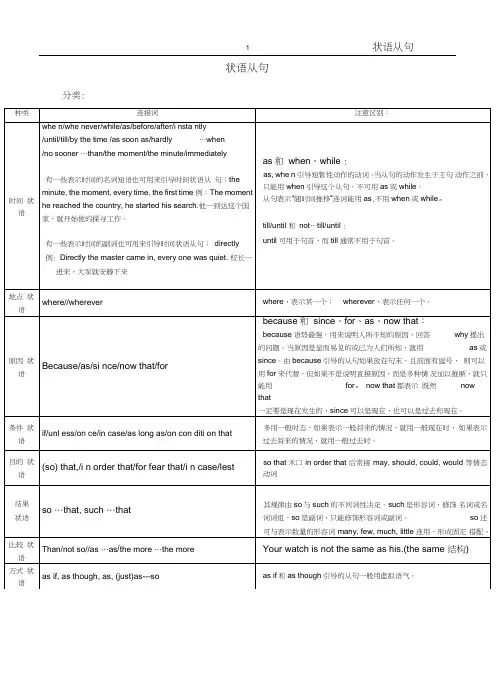
状语从句分类:3状语从句时间状语从句:when (当 .. 的时候)before (在 . 之前)while (在 ... 期间) since (自从 .. 以来)as soon as 一 .... 就 ... ) after (在 ... 之后) not …till/until (直至U .............. 才) no sooner …than 冈"( 就)地点状语从句: where (在那里) wherever (无论哪里)原因状语从句: because 因为) si nee (因为,既然)as (由于) for (为了) now that (既然)目的状语从句: (so ) that=in order that (以便) so as (not ) to (以便[不])in case (以免) lest (以免)结果状语从句:so+adj./adv.+that (如此 .... 以致)so that (结果 .. )such+n.+that (如果 .... 以致)that (所以,因此)让步状语从句:though/although 不可同but 连用。
though/although (虽然) however (可是)even though/if (即使)no matter+what/which/where/who/whe n =whatever/whichever/wherever/whoever/whe never(不论什么/哪一个/哪里/谁/何时)as (正如) as …as (和 ... 一样) not as/so …a (不如 ...... ) than (比 .. 更)the+比较级…+the+比较级 (越 ....... 越 ..... )if (假设)unless (如果不) so long as (只要)on condition that (如果) as (像 ... 那样地)just as (正像)as if (好像)as though (好像)各种状语从句的简化方法:1 .以after 和before 引导的状语从句的主语若与主句主语一致时, 从句等于after/before+doing sth.作状语。
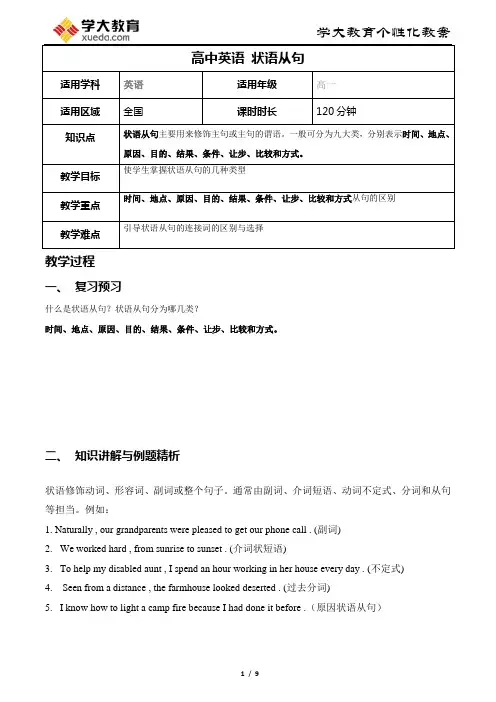
教学过程一、复习预习什么是状语从句?状语从句分为哪几类?时间、地点、原因、目的、结果、条件、让步、比较和方式。
二、知识讲解与例题精析状语修饰动词、形容词、副词或整个句子。
通常由副词、介词短语、动词不定式、分词和从句等担当。
例如:1. Naturally , our grandparents were pleased to get our phone call . (副词)2. We worked hard , from sunrise to sunset . (介词状短语)3. To help my disabled aunt , I spend an hour working in her house every day . (不定式)4. Seen from a distance , the farmhouse looked deserted . (过去分词)5. I know how to light a camp fire because I had done it before .(原因状语从句)状语的位置比较灵活,可以位于句首、句末或句中。
enough用作状语修饰形容词和副词时必须后置。
状语从句主要用来修饰主句或主句的谓语。
一般可分为九大类,分别表示时间、地点、原因、目的、结果、条件、让步、比较和方式。
尽管种类较多,但由于状语从句与汉语结构和用法相似,所以理解和掌握它并不难。
状语从句的关键是要掌握引导不同状语从句的常用连接词和特殊的连接词即考点。
现分别列举如下:1.时间状语从句常用引导词:when, as, while, as soon as, while, before, after, since , till, until特殊引导词:the minute, the moment, the second, every time, the day,the instant, immediately , directly, no sooner … than, hardly …when, scarcely … whenI didn’t realize how special my mother was until I became an adult.While John was watching TV, his wife was cooking.The children ran away from the orchard(果园) the moment they saw the guard.No sooner had I arrived home than it began to rain.Every time I listen to your advice, I get into trouble.2.地点状语从句常用引导词:where特殊引导词:wherever, anywhere, everywhereGenerally, air will be heavily polluted where there are factories.Wherever you go, you should work hard.3.原因状语从句常用引导词:because, since, as, since特殊引导词:seeing that, now that, in that, considering that, given that, considering that,My friends dislike me because I’m handsome and successful.Now that everybody has come, let’s begin our conference.The higher income tax is harmful in that it may discourage people from trying to earn more. Considering that he is no more than 12 years old, his height of 1.80 m is quite remarkable.4.目的状语从句常用引导词:so that, in order that特殊引导词:lest, in case, for fear that,in the hope that, for the purpose that, to the end thatThe boss asked the secretary to hurry up with the letters so that he could sign them.The teacher raised his voice on purpose that the students in the back could hear more clearly.5.结果状语从句常用引导词:so … that, so… that, such … that,特殊引导词:such that, to the degree that, to the extent that, to such a degree that,He got up so early that he caught the first bus.It’s such a good chance that we must not miss it.To such an degree was he excited that he couldn’t sleep last night.6.条件状语从句常用引导词:if, unless,特殊引导词:as/so long as, only if, providing/provided that, suppose that, in case that, on condition thatWe’ll start our project if the president agrees.You will certainly succeed so long as you keep on trying.Provided that there is no opposition, we shall hold the meeting here.7.让步状语从句常用引导词:though, although, even if, even though特殊引导词:as(用在让步状语从句中必须要倒装),while ( 一般用在句首),no matter (i)spite of the fact that, while, whatever, whoever, wherever, whenever, however, whicheverMuch as I respect him, I can’t agree to his proposal.尽管我很尊敬他,我却不同意他的建议。
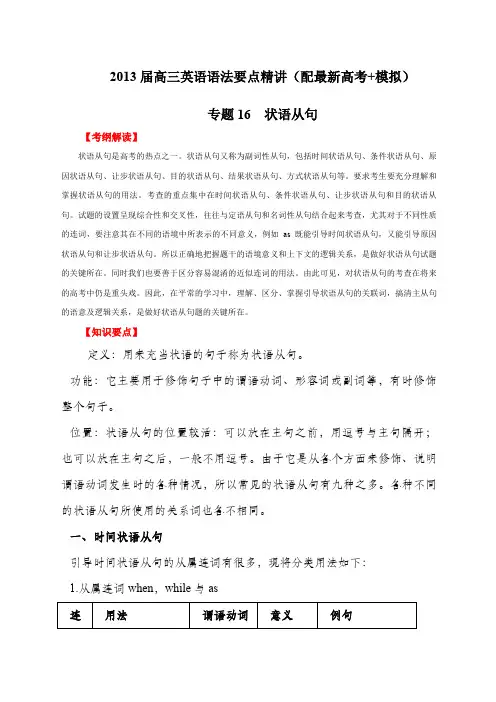
2013届高三英语语法要点精讲(配最新高考+模拟)专题16 状语从句【考纲解读】状语从句是高考的热点之一。
状语从句又称为副词性从句,包括时间状语从句、条件状语从句、原因状语从句、让步状语从句、目的状语从句、结果状语从句、方式状语从句等。
要求考生要充分理解和掌握状语从句的用法。
考查的重点集中在时间状语从句、条件状语从句、让步状语从句和目的状语从句。
试题的设置呈现综合性和交叉性,往往与定语从句和名词性从句结合起来考查,尤其对于不同性质的连词,要注意其在不同的语境中所表示的不同意义,例如as既能引导时间状语从句,又能引导原因状语从句和让步状语从句。
所以正确地把握题干的语境意义和上下文的逻辑关系,是做好状语从句试题的关键所在。
同时我们也要善于区分容易混淆的近似连词的用法。
由此可见,对状语从句的考查在将来的高考中仍是重头戏。
因此,在平常的学习中,理解、区分、掌握引导状语从句的关联词,搞清主从句的语意及逻辑关系,是做好状语从句题的关键所在。
【知识要点】定义:用来充当状语的句子称为状语从句。
功能:它主要用于修饰句子中的谓语动词、形容词或副词等,有时修饰整个句子。
位置:状语从句的位置较活:可以放在主句之前,用逗号与主句隔开;也可以放在主句之后,一般不用逗号。
由于它是从各个方面来修饰、说明谓语动词发生时的各种情况,所以常见的状语从句有九种之多。
各种不同的状语从句所使用的关系词也各不相同。
一、时间状语从句引导时间状语从句的从属连词有很多,现将分类用法如下:1.从属连词when,while与as注:1)when还可作并列连词,其意义为“那时,这时”,相当于and at this/that time。
常用于下列句式:sb.was doing sth.when...某人正在干某事就在这时sb.was about to/ going to do sth.when...某人正打算干某事就在这时sb.body has just done somesth.when...某人刚干了某事就在这时2)when还表示原因“既然”。
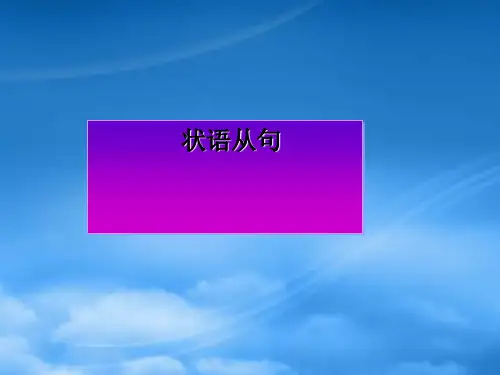
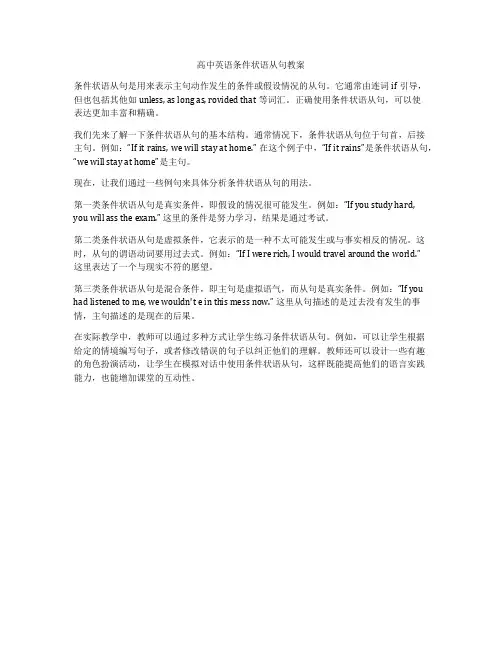
高中英语条件状语从句教案条件状语从句是用来表示主句动作发生的条件或假设情况的从句。
它通常由连词if引导,但也包括其他如unless, as long as, rovided that等词汇。
正确使用条件状语从句,可以使表达更加丰富和精确。
我们先来了解一下条件状语从句的基本结构。
通常情况下,条件状语从句位于句首,后接主句。
例如:“If it rains, we will stay at home.” 在这个例子中,“If it rains”是条件状语从句,“we will stay at home”是主句。
现在,让我们通过一些例句来具体分析条件状语从句的用法。
第一类条件状语从句是真实条件,即假设的情况很可能发生。
例如:“If you study hard, you will ass the exam.” 这里的条件是努力学习,结果是通过考试。
第二类条件状语从句是虚拟条件,它表示的是一种不太可能发生或与事实相反的情况。
这时,从句的谓语动词要用过去式。
例如:“If I were rich, I would travel around the world.”这里表达了一个与现实不符的愿望。
第三类条件状语从句是混合条件,即主句是虚拟语气,而从句是真实条件。
例如:“If you had listened to me, we wouldn't e in this mess now.” 这里从句描述的是过去没有发生的事情,主句描述的是现在的后果。
在实际教学中,教师可以通过多种方式让学生练习条件状语从句。
例如,可以让学生根据给定的情境编写句子,或者修改错误的句子以纠正他们的理解。
教师还可以设计一些有趣的角色扮演活动,让学生在模拟对话中使用条件状语从句,这样既能提高他们的语言实践能力,也能增加课堂的互动性。
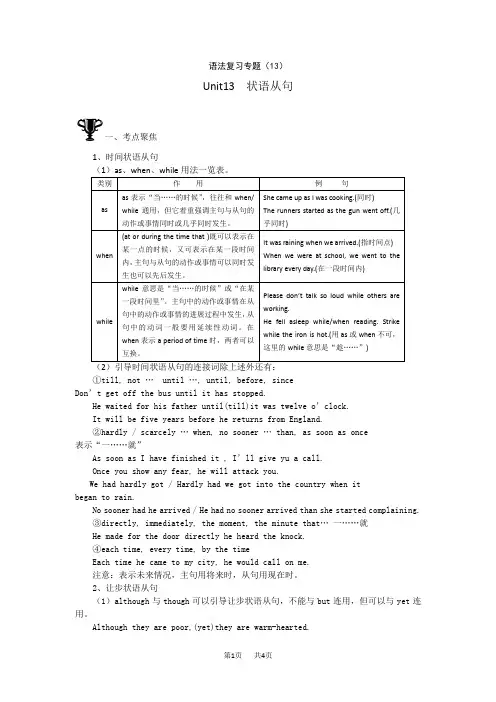
语法复习专题(13)Unit13 状语从句一、考点聚焦1、时间状语从句①till, not … until …, until, before, sinceDon’t get off the bus until it has stopped.He waited for his father until(till)it was twelve o’clock.It will be five years before he returns from England.②hardly / scarcely … when, no sooner … than, as soon as once表示“一……就”As soon as I have finished it , I’ll give yu a call.Once you show any fear, he will attack you.We had hardly got / Hardly had we got into the country when itbegan to rain.No sooner had he arrived / He had no sooner arrived than she started complaining.③directly, immediately, the moment, the minut e that… 一……就He made for the door directly he heard the knock.④each time, every time, by the timeEach time he came to my city, he would call on me.注意:表示未来情况,主句用将来时,从句用现在时。
2、让步状语从句(1)although与though可以引导让步状语从句,不能与but连用,但可以与yet连用。
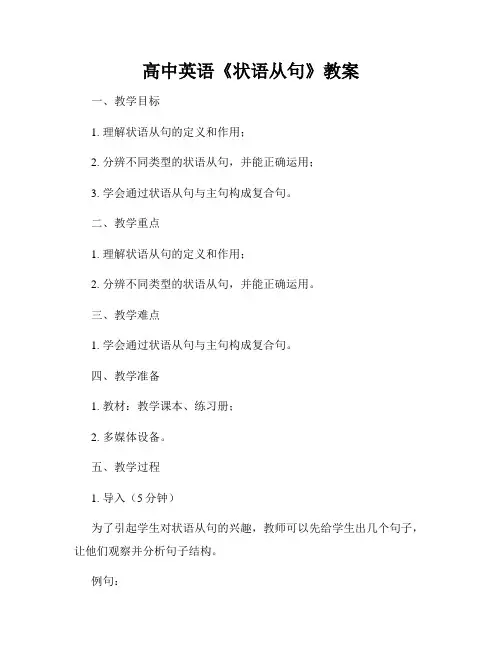
高中英语《状语从句》教案一、教学目标1. 理解状语从句的定义和作用;2. 分辨不同类型的状语从句,并能正确运用;3. 学会通过状语从句与主句构成复合句。
二、教学重点1. 理解状语从句的定义和作用;2. 分辨不同类型的状语从句,并能正确运用。
三、教学难点1. 学会通过状语从句与主句构成复合句。
四、教学准备1. 教材:教学课本、练习册;2. 多媒体设备。
五、教学过程1. 导入(5分钟)为了引起学生对状语从句的兴趣,教师可以先给学生出几个句子,让他们观察并分析句子结构。
例句:a) While I was studying, my phone rang.b) If it rains tomorrow, we won't go to the park.引导学生思考这些句子中的从句是什么作用,并引导他们尝试理解状语从句的概念。
2. 知识讲解(15分钟)解释状语从句的定义和作用,强调状语从句与主句的关系,并通过几个例句进一步说明。
教师可以按照以下顺序讲解不同类型的状语从句:a) 时间状语从句b) 条件状语从句c) 原因状语从句d) 结果状语从句e) 目的状语从句解释每个类型的状语从句时,可以给出相应的例句,并解释例句中状语从句的用法和意义。
3. 练习与巩固(25分钟)通过练习题帮助学生巩固所学的知识。
例题:1. _______ I was reading a book, the phone rang.a) Ifb) Whilec) Becaused) So2. We won't go to the park _______ it rains.a) whenb) ifc) becaused) so让学生独立完成练习题,并检查答案,解释正确答案的原因。
4. 拓展与应用(15分钟)通过提供更复杂的句子和情境,让学生在实际应用中运用状语从句。
例句:a) If I have time, I will visit my grandparents this weekend.b) Unless you apologize, I won't forgive you.教师可以组织学生分组讨论、编写对话或者写作,要求他们使用状语从句构成复杂句。
状语从句一.分类:when (当……的时候) while (在……期间) as (当……的时候, 一边……一边……)before (在……之前) since (自从……以来) till/until (直到) hardly…when… (刚……就) as soon as (一……就……)after (在……之后) not…till/until(直到……才)no sooner…than…(刚……就)地点状语从句:where (在那里) wherever(无论哪里)原因状语从句:because (因为) since (因为,既然) as (由于) for (为了) now that(既然)目的状语从句:(so)that=in order that(以便)so as (not)to (以便[不])in case(以免)lest(以免)结果状语从句:so+adj./adv.+that(如此……以致)so that(结果……)such+n.+that(如果……以致)that(所以,因此)让步状语从句:though/although不可同but连用。
though/although (虽然)however (可是)even though(即使)even if (即使)no matter+what/which/where/who/when =whatever/whichever/wherever/whoever/whenever(不论什么/哪一个/哪里/谁/何时)比较状语从句:as (正如)as…as(和……一样)not as/so … as (不如……)than(比……更)the+比较级…+the+比较级(越……越……)条件状语从句:if(假设)unless(如果不)so long as(只要)on condition that (如果)方式状语从句:as(像……那样地)just as(正像)as if(好像)as though(好像)二.各种状语从句的简化方法:1例:After she sang,she left the rich man's house.= After singing,she left the rich man's house.2.以as soon as引导的状语从句的主语若与主句主语一致时,从句等于on+doing sth.,作状语,此时的动词为非延续性动词。
高中英语词法专题状语从句教案Teaching plan of adverbial clause in Senior Hi gh School高中英语词法专题状语从句教案前言:小泰温馨提醒,英语作为在许多国际组织或者会议上都是必需语言,几乎所有学校选择英语作为其主要或唯一的外语必修课。
英语教学涉及多种专业理论知识,包括语言学、第二语言习得、词汇学、句法学、文体学、语料库理论、认知心理学等内容。
本教案根据英语课程标准的要求和针对教学对象是高中生群体的特点,将教学诸要素有序安排,确定合适的教学方案的设想和计划、并以启迪发展学生智力为根本目的。
便于学习和使用,本文下载后内容可随意修改调整及打印。
英语词法专题讲座十六:状语从句一、引导词的选择:1.时间状语从句1). 由when、while、as(当……时候)引导的时间状语从句。
when jack got home, his mother was cooking.2). 由after/ before (在….之后/ 前)引导的时间状语从句。
the football match played after school was over.3). 由as soon as (一…..就……)引导的时间状语从句。
i’ll ring you as soon as i reach beijing.4). 由not….until(直到…..才…..)引导的时间状语从句。
they didn’t stop until they finished the work.2.原因状语从句由because、since、as(因为、既然、由于)引导的原因状语从句。
since you have known about that, please tell us what to do.3.地点状语从句由wherever(无论在哪儿)引导的地点状语从句。
wherever he goes, he always brings his pet dog.4.目的状语从句由so that (以便、为的是)引导目的状语从句。
状语从句一、概述:状语从句修饰主句中的动词、形容词、副词等,在复合句中作状语。
引导状语从句的关联词是从属连词。
状语从句用陈述句语序,一般位于复合句的句首或句末。
当从句放在主句前面时,常用逗号与主句隔开。
状语从句根据其在句中的不同作用可以分为时间、地点、原因、目的、结果、条件、让步、方式和比较状语从句九种。
二、用法:(一)时间状语从句的用法:1、注意点:⑴在时间、条件状语从句中,谓语动词一般不用将来时态表示将来,而用一般现在时态代替一般将来时态,用一般过去时态代替过去将来时态,用现在完成时态代替将来完成时态。
如:When he comes here,I will let you know. When I have finished reading the book,I will tell you.注意:when可以引导时间状语从句,还可以引导宾语、主语等名词性从句;if可以引导条件状语从句,也可以引导宾语从句(引导条件状语从句时,意为“如果,假如”,引导宾语从句时,意为“是否”);注意当它们引导时间和条件状语从句时,要用一般现在时态表示将来,引导宾语等名词性从句时,仍然要用一般将来时态表示将来。
如:When he comes here, please tell me. W hen he will come here hasn’t been decided yet.If he has any questions,he will come to ask me. Tell me if you will go to school tomorrow.(2)时间、条件、方式、让步等状语从句常常可以转换成省略形式或简单句句子成分。
①when,while,as,if,though,as if等引导时间、条件、方式、让步等状语从句时,若从句和主句的主语一致或主句的主语是it且含有be动词时,可以将从句中的主语连同后面的be动词一起省略。
状语从句学目: 1 .掌握九种常用的状从句及其常用的接 2.掌握常考点和点一.九种常的状从句/地点/原因/条件/步/果/目的/方式/比状从句二.接,考点与点1.状从句接 : when, while, as, before, after, as soon as, till, until, not⋯until, every time,the first/second⋯/last time, the moment/ minute/ instant/second, immediately, directly,instantly, hardly/ scarcely⋯when, no sooner⋯than考点 1: 1.-Did you remember to give Mary the money you owed her?- Yes. I gave it to her _____ I saw her. A. while B. the moment C. suddenly D. once2. I thought her nice and honest ______ I met her.A. first timeB. for the first timeC. the first timeD. by the first time3. ______ entered the office when he realized that he had forgotten his report.A. He hardly hadB. Had he hardlyC. Hardly had heD. Hardly he had4.加一个 the day的例句: 1)一些,如the moment, the minute,the instant,immediately,directly,instantly, hardly ⋯when, scarcely ⋯when, no sooner ⋯than等也可引状从句,相当于________________ 意思。
2) 一些含有time 的名短,如every time, each time, next time, by the time ,和the first/se cond⋯/last time,以及the day, the year, the morning等,也可引状从句。
如: The day he returned home, his father was already dead.考点 2: 1. (北京) We were swimming in the lake ______ suddenly the storm started.A. whenB. whileC. untilD. before2. (上海) He was about to tell me the secret ______ someone patted him on theshoulder.A. asB. untilC. whileD. when3. ( 宁 ) He was about halfway through his meal ______ a familiar voice came tohis ears.A. whyB. whereC. whenD. while: when = _____________________就在那/后接瞬,常用于下列句式:Somebody be doing sth when⋯Somebody be about to do sth when⋯somebody had just done sth when⋯Somebody be on the point of doing sth when⋯考点 3: 1. He transplanted the little tree to the garden ______ it was the best timefor it.A. whereB. whenC. thatD. until2. It was f oolish of you to take a taxi ____________ you could easily walk there in five minutes.: ____________ 表示原因相当于considering that,______________考点 4:As time goes on, it’s getting colder and colder. =________________ , it’s getting colder and colder.As the election approached, the violence got worse. = __________________, the violence got worse.: _______________ 表示“随着⋯⋯”,可用_____________ 构替考点 5:It was not ______ she took off her dark glasses______ I realized she was a famousfilm star.A. when; thatB. until; thatC. until; whenD. when; thenI had no idea of it until you told me.改句:It was________________ that I hadany idea of it.改成倒装句:Not until you told me _____________________________ any idea of it.:句中,not until从句一起作被部分,放在that之前。
Not until的倒装句,until引的从句________________,______________倒装。
考点 6: before的含1.Itwill be two years before he leaves the country. _____________________________2.It won’t be long before he comes back._____________________________3.It is three years since she joined the army._____________________________: 1)句型 It will be/was+段+ before ⋯“要多久才⋯⋯”2)句型 It will be/was not+段+before⋯“用不了多久就⋯⋯”3)句型 It is/has been+段+since⋯ 自从。
: 1.要半年我才回来。
_________________________________2.不到 2 年他就离开了个国家。
_________________________________3.自从争爆已有 3 年了。
_______________________________________4. We had sailed four days and four nights before we saw land. ____________5.We hadn’t run a mile before he felt tired. _______________6. Please write it down before you forget it. _____________________7. The man hung up the phone before I could answer it. ____________________8. He made a mistake, but then he corrected the situation ______ it got worse.A. untilB. whenC. beforeD. as9. Scientists say it may be five or six years_____ it is possible to test this medicineon human patients. A. since B. after C. before D. when10. -Why didn’t you tell him about the meeting? - He rushed out of the room ____ I could say a word.A. beforeB. untilC. whenD. after考点 6: By the time you get there, the work __________________________________. (finish) By now, we _____________________ English for six years. (learn)By the time he arrived, the plane _________________ off. (take): by 引状,主句要与______________用。
当从句表示将来,在,去分用________________________________________.2. 地点状从句接: where, whereverWherever you go, you should do your work well. = ____________________ you go,⋯.3.原因状从句接 : because, for, since, as, now( that), in that, seeing / considering/given that,when____________/___________ you are not interested, I won’t tell you about it.既然Some people say man differs from animals ______________we have the ability to laugh.在于 / 因____________/________ that his wife has just had a bad cold, he decided to go to the party alo ne.考到_____________ that quite a few people were absent, we decided to put the meeting off.由于4.条件状从句接: if,unless,as long as /on condition that,suppose/supposing(that), provided/providing (that)I won ’t go to the party unless invited.相当于__________,意思是“除非⋯”“如果不⋯就⋯”We’ll let you use the room on condition that you keep it clean.只要=_____________ Provided/Providing (that)we invite him, he would surely come to dinner.假如Suppose/supposing (that) we can’t get enough food, what shall we do?假考点 1: 1. You can borrow my car _____ you promise not to drive too fast.A. unlessB. even ifC. in caseD. as long as2._____ I can see, there is only one possible way to keep away from the danger.A. As long asB. As far asC. Just asD. Even if:as long as表示“只要⋯”,as far as表示“就⋯而(而言)”。